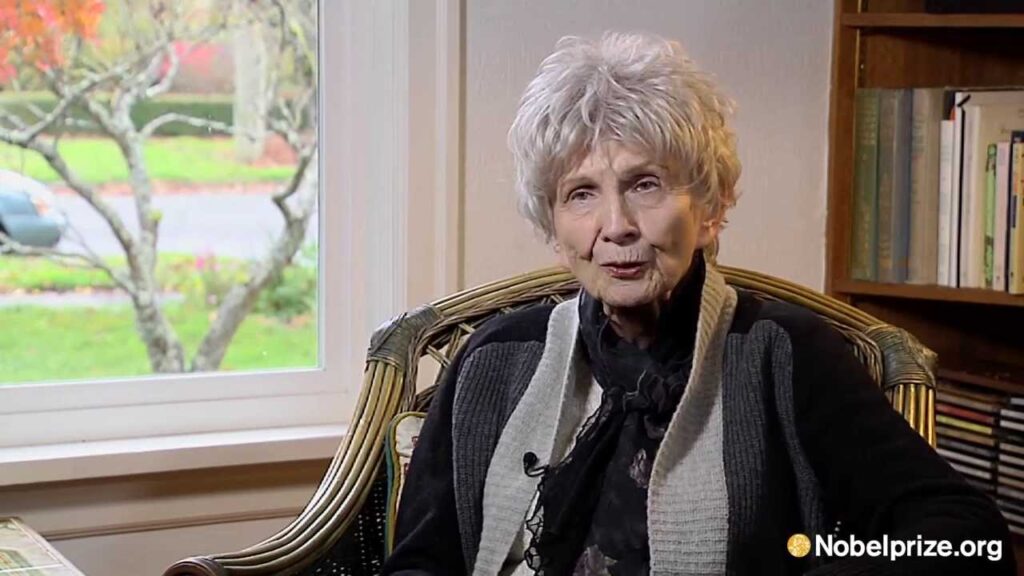Note: Back in 2013, when Alice Munro won the Nobel Prize in Literature, we published a post featuring 20 short stories written by Munro. Today, with the sad news that Alice Munro has passed away, at the age of 92, we’re bringing the original post (from October 10, 2013) back to the surface–in part because you can still read the 20 stories free online. Please find the stories at the bottom of this post.
Calling her a “master of the contemporary short story,” the Swedish Academy awarded 82-year-old Alice Munro the Nobel Prize in Literature today. It is well-deserved, and hard-earned (and comes not long after she announced her retirement from fiction). After 14 story collections, Munro has reached at least a couple generations of writers with her psychologically subtle stories about ordinary men and women in Huron County, Ontario, her birthplace and home. Only the 13th woman writer to win the Nobel, Munro has previously won the Man Booker Prize in 2009, the Governor General’s Literary Award for Fiction in Canada three times (1968, 1978, and 1986), and two O. Henry Awards (2006 and 2008). Her regional fiction draws as much from her Ontario surroundings as does the work of the very best so-called “regional” writers, and captivating interactions of character and landscape tend to drive her work more so than intricate plotting.
Of that region she loves, Munro has said: “It means something to me that no other country can—no matter how important historically that other country may be, how ‘beautiful,’ how lively and interesting. I am intoxicated by this particular landscape… I speak the language.” The language she may have learned from the “brick houses, the falling-down barns, the trailer parks, burdensome old churches, Wal-Mart and Canadian Tire.” But the short story form she learned from writers like Carson McCullers, Flannery O’Connor, and Eudora Welty. She names all three in a 2001 interview with The Atlantic, and also mentions Chekhov and “a lot of writers that I found in The New Yorker in the fifties who wrote about the same type of material I did—about emotions and places.”
Munro was no young literary phenom—she did not achieve fame in her twenties with stories in The New Yorker. A mother of three children, she “learned to write in the slivers of time she had.” She published her first collection, Dance of the Happy Shades in 1968 at 37, an advanced age for writers today, so many of whom have several novels under their belts by their early thirties. Munro always meant to write a novel, many in fact, but “there was no way I could get that kind of time,” she said:
Why do I like to write short stories? Well, I certainly didn’t intend to. I was going to write a novel. And still! I still come up with ideas for novels. And I even start novels. But something happens to them. They break up. I look at what I really want to do with the material, and it never turns out to be a novel. But when I was younger, it was simply a matter of expediency. I had small children, I didn’t have any help. Some of this was before the days of automatic washing machines, if you can actually believe it. There was no way I could get that kind of time. I couldn’t look ahead and say, this is going to take me a year, because I thought every moment something might happen that would take all time away from me. So I wrote in bits and pieces with a limited time expectation. Perhaps I got used to thinking of my material in terms of things that worked that way. And then when I got a little more time, I started writing these odder stories, which branch out a lot.
Whether Munro’s adherence to the short form has always been a matter of expediency, or whether it’s just what her stories need to be, hardly matters to readers who love her work. She discusses her “stumbling” on short fiction in the interview above from 1990 with Rex Murphy. For a detailed sketch of Munro’s early life, see her wonderful 2011 biographical essay “Dear Life” in The New Yorker. And for those less familiar with Munro’s exquisitely crafted narratives, we offer you below several selections of her work free online. Get to know this author who, The New York Times writes, “revolutionized the architecture of short stories.”
“Voices” – (2013, Telegraph)
“A Red Dress—1946” (2012–13, Narrative—requires free sign-up)
“Amundsen” (2012, The New Yorker)
“Train” (2012, Harper’s)
“To Reach Japan” (2012, Narrative—requires free sign-up)
“Axis” (2001, The New Yorker — in audio)
“Gravel” (2011, The New Yorker)
“Fiction” (2009, Daily Lit)
“Deep Holes” (2008, The New Yorker)
“Free Radicals” (2008, The New Yorker)
“Face” (2008, The New Yorker)
“Dimension” (2006, The New Yorker)
“Wenlock Edge” (2005, The New Yorker)
“The View from Castle Rock” (2005, The New Yorker)
“Passion” (2004, The New Yorker)
“Runaway” (2003, The New Yorker)
“Some Women” (2008, New Yorker)
“The Bear Came Over the Mountain” (1999, The New Yorker)
“Queenie” (1998, London Review of Books
“Boys and Girls” (1968)
Related Content:
Josh Jones is a writer and musician based in Durham, NC. Follow him at @jdmagness

